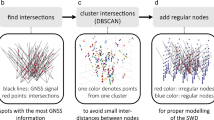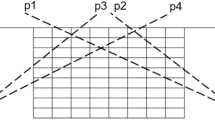Abstract
Using the observations from local and regional GPS networks, the estimation of slant wet delays (SWDs) is possible for each line of sight between satellite and receiver. The observations of SWD are used to model horizontal and vertical variations of the wet refractivity in the atmosphere above the study area. This work is done using the tomography method. In tomography, the horizontal variations of tropospheric wet refractivity are modeled with the polynomial in degree and rank of 2 with latitude and longitude as variables. Also, altitude variations are modeled in the form of discrete layers with constant heights. The main innovation is to estimate the tropospheric parameters for each line of sight by the artificial neural networks (ANNs). The SWD obtained from GPS observations for the different signals at each station is compared with the SWD generated by the ANNs (SWDGPS–SWDANNs). The square of the difference between these two values is introduced as the cost function in the ANNs. To evaluate, we used observations from October 27 to 31, 2011. The availability of GPS and radiosonde data is the main reason for choosing this timeframe. The correlation coefficient, root mean square error (RMSE), and relative error allow for evaluation of the proposed model. The results were also compared with the results of the voxel-based troposphere tomography method. For a more detailed evaluation, four test stations are selected and ANN zenith wet delays (ZWDANN) are compared with the ZWDGPS. Observations of test stations are not used in the modeling step. The correlation coefficient in the testing step for TomoANN and Tomovoxel is 0.9006 and 0.8863, respectively. The mean RMSE at 5 days for TomoANN and Tomovoxel is calculated as 0.63 and 0.71 mm/km, respectively. Also, the average relative error at the four test stations for TomoANN is 15.37% and for Tomovoxel it is 19.69%. The results demonstrate the better capability of the proposed method in the modeling of the tropospheric wet refractivity in the region of Iran.







Similar content being viewed by others
Data Availability
Tabriz radiosonde data can be obtained from the Iranian Meteorological Organization. Also, observations of GPS stations in the northwest of Iran (Azarbayjan network) are available at the National Cartographic Center of Iran. All data and results in this paper can be provided to readers by contacting the corresponding author.
References
Adavi Z, Mashhadi Hossainali M (2014) 4D-tomographic reconstruction of the tropospheric wet refractivity using the concept of virtual reference station, case study: North West of Iran. Meteorol Atmos Phys 126(3–4):193–205
Aster R, Borchers B, Thurber C (2003) Parameter estimation and inverse problems, vol 90. Elsevier Academic Press, New York
Benevides P, Catalao J, Nico G, Miranda P (2018) 4D wet refractivity estimation in the atmosphere using GNSS tomography initialized by radiosonde and AIRS measurements: results from a 1-week intensive campaign. GPS Solut 22(4):91
Bevis M, Businger S, Herring T, Rocken C, Ware RH (1992) GPS metrology: remote sensing of atmospheric water vapor using the global positioning system. J Geophys Res 97(D14):15787–15801
Böhm J, Niell A, Tregoning P, Schuh H (2006) Global mapping function (GMF): a new empirical mapping function based on numerical weather model data. Geophys Res Lett. https://doi.org/10.1029/2005GL02554
Bosy J, Rohm W, Sierny J (2010) The concept of the near real time atmosphere model based on the GPS and the meteorological data from the ASG-EUPOS reference stations. Acta Geodyn Geomater 7(3):253–261
Chen B, Liu Z (2014) Voxel-optimized regional water vapor tomography and comparison with radiosonde and numerical weather model. J Geodesy 88(7):691–703
Dach R, Hugentobler U, Fridez P, Meindl M (2007) Bernese GPS software version 5.0. Astronomical Institute, University of Bern, Bern
Emardson TR, Elgered G, Johansson JM (1998) Three months of continuous monitoring of atmospheric water vapor with a network of Global Positioning System receivers. J Geophys Res 103(D2):1807–1820
Ghaffari Razin MR (2015) Development and analysis of 3D ionosphere modeling using base functions and GPS data over Iran. Acta Geod Geophys 51(1):95–111
Ghaffari Razin MR, Voosoghi B (2017) Ionosphere tomography using wavelet neural network and particle swarm optimization training algorithm in Iranian case study. GPS Solut 21(3):1301–1314
Ghaffari Razin MR, Voosoghi B, Mohammadzadeh A (2015) Efficiency of artificial neural networks in map of total electron content over Iran. Acta Geod Geophys 51(2016):541–555. https://doi.org/10.1007/s40328-015-0143-3
Haji Aghajany S, Amerian Y (2017) three dimensional ray tracing technique for tropospheric water vapor tomography using GPS measurements. J Atmos Solar Terr Phys 164(2017):81–88
Menke W (2012) Geophysical data analysis: discrete inverse theory MATLAB, 3rd edn. Academic Press is an imprint of Elsevier, Amsterdam
Ortiz de Galisteo J, Toledano C, Cachorro C, Torres B (2010) Improvement in PWV estimation from GPS due to the absolute calibration of antenna phase center variations. GPS Solut 14(4):389–395
Saastamoinen J (1973) Contributions to the theory of atmospheric refraction. Part II: refraction corrections in satellite geodesy. Bull Geod 107:13–34
Selbesoglu MO (2019) Prediction of tropospheric wet delay by an artificial neural network model based on meteorological and GNSS data. Eng Sci Technol Int J. https://doi.org/10.1016/j.jestch.2019.11.006
Shangguan M, Bender M, Ramatschi M, Dick G, Wickert J, Raabe A, Gales R (2013) GPS tomography: validation of reconstructed 3-D humidity fields with radiosonde profiles. Ann Geophys 31(9):1491–1505
Skone S, Hoyle V (2005) Troposphere modeling in a regional GPS network. J Glob Position Syst 4(1–2):230–239
Wilgan K, Hurter F, Geiger A, Rohm W, Bosy J (2017) Tropospheric refractivity and zenith path delays from least-squares collocation of meteorological and GNSS data. J Geodesy 91(2):117–134
Xin W, Daren L (2005) Retrieval of water vapor profiles with radio occultation measurements using an artificial neural network. Adv Atmos Sci 22(5):759–764
Yao Y, Zhao Q (2016) A novel optimized approach of voxel division for water vapor tomography. Meteorol Atmos Phys 129(2016):57–70
Zhang JR, Zhang J, Lok T, Lyu M (2007) A hybrid particle swarm optimization—back-propagation algorithm for feed forward neural network training. Appl Math Comput 185(2007):1026–1037
Zhao Q, Zhang K, Yao Y, Li X (2019) A new troposphere tomography algorithm with a truncation factor model (TFM) for GNSS networks. GPS Solut 23(3):64
Zheng DY, Hu WS, Wang J, Zhu MC (2015) Research on regional zenith tropospheric delay based on neural network technology. Surv Rev 47(343):286–295
Acknowledgement
The authors of this paper appreciate the National Cartographic Center (NCC) of Iran for providing GPS data from the IPGN. Also, the authors thank the reviewers and editor, which provided valuable insights to improve the results of the paper. This paper was supported by the Iran National Science Foundation and K. N. Toosi University of Technology (Project No. 96008789).
Author information
Authors and Affiliations
Corresponding author
Additional information
Publisher's Note
Springer Nature remains neutral with regard to jurisdictional claims in published maps and institutional affiliations.
Rights and permissions
About this article
Cite this article
Ghaffari Razin, MR., Voosoghi, B. Estimation of tropospheric wet refractivity using tomography method and artificial neural networks in Iranian case study. GPS Solut 24, 65 (2020). https://doi.org/10.1007/s10291-020-00979-y
Received:
Accepted:
Published:
DOI: https://doi.org/10.1007/s10291-020-00979-y




